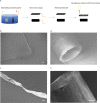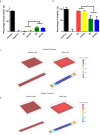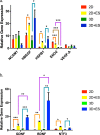Controlling properties of human neural progenitor cells using 2D and 3D conductive polymer scaffolds
- PMID: 31863072
- PMCID: PMC6925212
- DOI: 10.1038/s41598-019-56021-w
Controlling properties of human neural progenitor cells using 2D and 3D conductive polymer scaffolds
Abstract
Human induced pluripotent stem cell-derived neural progenitor cells (hNPCs) are a promising cell source for stem cell transplantation to treat neurological diseases such as stroke and peripheral nerve injuries. However, there have been limited studies investigating how the dimensionality of the physical and electrical microenvironment affects hNPC function. In this study, we report the fabrication of two- and three-dimensional (2D and 3D respectively) constructs composed of a conductive polymer to compare the effect of electrical stimulation of hydrogel-immobilized hNPCs. The physical dimension (2D vs 3D) of stimulating platforms alone changed the hNPCs gene expression related to cell proliferation and metabolic pathways. The addition of electrical stimulation was critical in upregulating gene expression of neurotrophic factors that are important in regulating cell survival, synaptic remodeling, and nerve regeneration. This study demonstrates that the applied electrical field controls hNPC properties depending on the physical nature of stimulating platforms and cellular metabolic states. The ability to control hNPC functions can be beneficial in understanding mechanistic changes related to electrical modulation and devising novel treatment methods for neurological diseases.
Conflict of interest statement
There are no competing or conflicts of interest related to the work presented in this manuscript for the authors.
Figures




Similar articles
-
Electrical preconditioning of stem cells with a conductive polymer scaffold enhances stroke recovery.Biomaterials. 2017 Oct;142:31-40. doi: 10.1016/j.biomaterials.2017.07.020. Epub 2017 Jul 12. Biomaterials. 2017. PMID: 28719819 Free PMC article.
-
Human Rett-derived neuronal progenitor cells in 3D graphene scaffold as an in vitro platform to study the effect of electrical stimulation on neuronal differentiation.Biomed Mater. 2018 Mar 21;13(3):034111. doi: 10.1088/1748-605X/aaaf2b. Biomed Mater. 2018. PMID: 29442069
-
Electrical stimulation of human neural stem cells via conductive polymer nerve guides enhances peripheral nerve recovery.Biomaterials. 2021 Aug;275:120982. doi: 10.1016/j.biomaterials.2021.120982. Epub 2021 Jun 23. Biomaterials. 2021. PMID: 34214785 Free PMC article.
-
2D, 3D and 4D active compound delivery in tissue engineering and regenerative medicine.Curr Pharm Des. 2015;21(12):1506-16. doi: 10.2174/1381612821666150115153417. Curr Pharm Des. 2015. PMID: 25594405 Review.
-
Neural stem cell therapy-Brief review.Clin Neurol Neurosurg. 2018 Oct;173:8-14. doi: 10.1016/j.clineuro.2018.07.013. Epub 2018 Jul 18. Clin Neurol Neurosurg. 2018. PMID: 30053745 Review.
Cited by
-
Hybrid fibres: a new path in tissue regeneration.J Mater Sci Mater Med. 2025 Mar 26;36(1):29. doi: 10.1007/s10856-025-06875-6. J Mater Sci Mater Med. 2025. PMID: 40138044 Free PMC article.
-
Induced Pluripotency: A Powerful Tool for In Vitro Modeling.Int J Mol Sci. 2020 Nov 24;21(23):8910. doi: 10.3390/ijms21238910. Int J Mol Sci. 2020. PMID: 33255453 Free PMC article. Review.
-
3D-Printed Electroactive Hydrogel Architectures with Sub-100 µm Resolution Promote Myoblast Viability.Macromol Biosci. 2022 Aug;22(8):e2200103. doi: 10.1002/mabi.202200103. Epub 2022 Jun 3. Macromol Biosci. 2022. PMID: 35596668 Free PMC article.
-
Conducting polymer-based granular hydrogels for injectable 3D cell scaffolds.Adv Mater Technol. 2021 Jun;6(6):2100162. doi: 10.1002/admt.202100162. Epub 2021 Apr 25. Adv Mater Technol. 2021. PMID: 34179344 Free PMC article.
-
Carboxymethyl Chitosan and Gelatin Hydrogel Scaffolds Incorporated with Conductive PEDOT Nanoparticles for Improved Neural Stem Cell Proliferation and Neuronal Differentiation.Molecules. 2022 Nov 29;27(23):8326. doi: 10.3390/molecules27238326. Molecules. 2022. PMID: 36500418 Free PMC article.
References
Publication types
MeSH terms
Substances
Grants and funding
LinkOut - more resources
Full Text Sources

